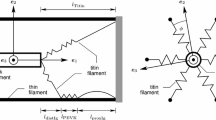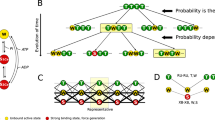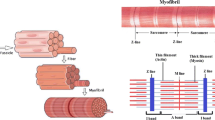Abstract
Two dynamic models of muscle activation and deactivation based on the concepts of ion transport, reaction rates, and muscle mechanics are proposed. Storage release and uptake of calcium by the sarcoplasmic reticulum, and a two-step chemical reaction of calcium and troponin are included in the first model. This is a concise version of the complex chemical reactions of muscle activation and deactivation in sarcoplasm. The second model is similar to the first, but calcium-troponin reactions are simplified into two nonlinear rates functions. Due to these nonlinear dynamics, the second model can explain the catch-like enhancement of isometric force response. Simulation results which match experimental data are shown. Also, two new phenomena which need further experiment to verify are predicted by the second model.
Similar content being viewed by others
References
Aidley DJ (1971a) The organization of muscle cells. In: The physiology of excitable cells, chap 11. Cambridge University Press, Cambridge
Aidley DJ (1971b) The dynamics of muscular contraction. In: The physiology of excitable cells, chap 12. Cambridge University Press, Cambridge
Almers W (1989) Excitation-contraction coupling in skeletal muscle. In: Textbook of physiology, vol 1: excitable cells and neurophysiology, chap 7, 21st edn. Seattle, Washington
Baldissera F, Parmiggiani F (1975) Relevance of motoneuronal firing adaptation to tension development in the motor unit. Brain Res 91:315–320
Burke RE, Rudomin P, Zajac FE (1970) Catch property in single mammalian motor units. Science 168:122–124
Burke RE, Rudomin P, Zajac FE (1976) The effect of activation history on tension production by individual muscle units. Brain Res 109:515–529
Ebashi S, Endo M (1968) Calcium ion and muscle contraction. Prog Biophys Mol Biol 18:123–183
Gordon AM (1989a) Molecular basis of contraction. In: Textbook of physiology, vol 1: excitable cells and neurophysiology, chap 8, 21st edn. Seattle, Washington
Gordon AM (1989b) Contraction in skeletal muscle. In: Textbook of physiology, vol 1: excitable cells and neurophysiology, chap 9, 21st edn. Seattle, Washington
Gurfinkel VS, Levik YS (1974) Effects of doublet or omission and their connexion with the dynamics of the active state of human muscles. Problems of information transmission. USSR Academy of Sciences, Moscow
Hannaford B (1990) A nonlinear model of the phasic dynamics of muscle activation. IEEE Trans Biomed Eng 37:1067–1075
Hannaford B, Kim WS, Lee SH, Stark L (1986) Neurological control of head movements: inverse modeling and electromyographic evidence. Math Biosci 78:159–178
Hannaford B, Stark L (1985) Roles of the elements of the tri-phasic control signal. Exp Neurol 90:619–634
Hannaford B, Stark L (1987) Late agonist burst (PC) required to optimal head movement: a simulation study. Biol Cybern 57:321–330
Hodgkin AL, Huxley AF (1952) A quantitative description of membrane currents and its application to conduction and excitation in nerve. J Physiol 117:500–544
Huxley AF (1957) Muscle structure and theories of contraction. Prog Biophys Biophys Chem 7:255–318
Lehman SL (1982) A detailed biophysical model of human extraocular muscle. Dissertation of Doctor of Philosophy in Biophysics of the University of California, Berkeley
Ling G (1992) A revolution in the physiology of the living cell: and beyond. Krieger, Melbourne, Florida
Pollack GH (1990) Muscles & molecules: uncovering the principles of biological motion, Seattle, Washington
Pringle J (1949) The excitation and contraction of the flight muscles of insects. J Physiol 149:29–30
Zahalek G (1990) Modeling muscle mechanics. In: Winters J, Woo S (eds) Multiple muscle systems. Springer, Berlin Heidelberg New York
Author information
Authors and Affiliations
Rights and permissions
About this article
Cite this article
Chou, CP., Hannaford, B. Dual stable point model of muscle activation and deactivation. Biol. Cybern. 66, 511–523 (1992). https://doi.org/10.1007/BF00204116
Received:
Accepted:
Issue Date:
DOI: https://doi.org/10.1007/BF00204116




